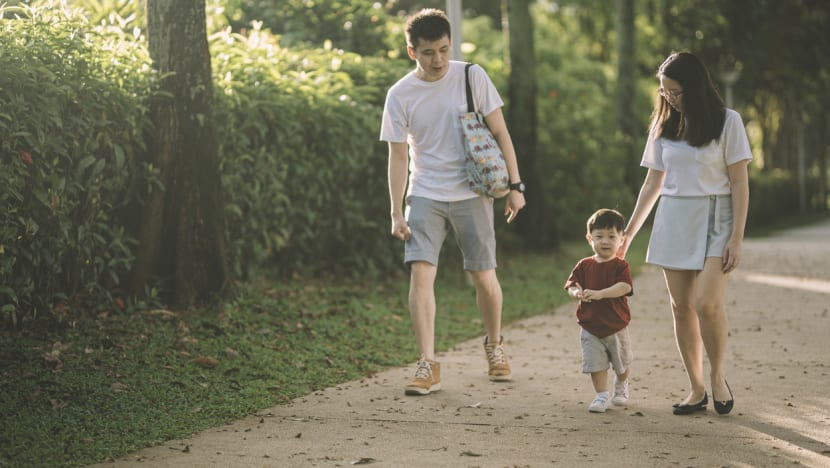Commentary: Taking your kid outdoors doesn't always have to be a grand adventure
This Earth Day, it is worth reflecting on why nature matters and how we are making it part of our children’s everyday lives, say three Singapore researchers.

Spending time in nature can reduce stress, improve mood and foster creativity. (Photo: iStock/Edwin Tan)

This audio is generated by an AI tool.
SINGAPORE: We want our kids to grow up well. But we also want 15 minutes of peace at dinner. So we hand them an iPad, despite knowing the downsides of too much screen time.
One of the most powerful antidotes lies all around us. Spending time in nature can reduce stress, improve mood and foster creativity. These benefits are especially critical for children with studies showing that contact with nature enhances cognitive functioning, mitigates symptoms of attention deficit hyperactivity disorder (ADHD) and improves emotional resilience.
It also creates space for what indoor routines often crowd out – unstructured play, sensory exploration and spontaneous curiosity.
But in the rush of daily life, outdoor time often gets deprioritised. Nature experiences become optional – nice to have but not essential.
As we mark Earth Day on Tuesday (Apr 22), it is worth reflecting not only on why nature matters but also how we are making it a part of our children’s everyday lives.
DISCOMFORT IN NATURE
Nature is slow, at times boring, and mostly sweaty. Screens are fast, frictionless and instantly rewarding.
They hijack the brain’s dopamine system – the same one that finds joy in novelty, discovery and surprise. Nature triggers these too, but not at the same speed.
That makes screens hard to put down, and nature harder to pick up.
This is true for us adults as well. Nature has to contend with Netflix, TikTok and livestreams. And when you add the unfamiliarity and discomfort of being outdoors in nature, the choice becomes even harder.
Many of us didn’t grow up with nature either. We were not taught to spot birds, walk barefoot or lie in the grass. So when our kid hesitates on a muddy trail or shrieks at a bug, we understand. Sometimes, we reinforce it: “Don’t touch that, it’s dirty!”
These moments matter more than we realise. A parent pulling their child away from a puddle; chiding them for sitting on the ground; rushing through a park instead of pausing under a tree. These habits can develop biophobia, or an aversion to nature, in children.
Over time, that childlike wonder dulls. Curiosity turns to caution, caution becomes avoidance.
SCREENS CANNOT REPLACE NATURE
Parents may think that putting on a nature documentary or educational cartoon at home is meaningful screen time for the kids.
But digital nature is not real nature. In our own research, participants who explored nature in virtual reality were more willing to see it as a substitute for the real thing. That’s not a win, it is a cause for concern.
Passive experiences of nature may dull our appreciation for the small and local. And in Singapore, that’s what much of our nature is.
We do not have mountaintops, waterfalls or vast wilderness. We have rain trees, otters swimming down canals and birds nesting on traffic lights. Ordinary nature; everyday wonder.
GETTING GREEN WITH SCREENS
While screens are not a replacement for nature, they are not the enemy. On the contrary, they can be part of the solution.
Google Maps and trail-finder apps can guide families to green spaces they never knew about. Smartphone apps that identify plants and birds can spark curiosity. Parents can involve their children by letting them take photos, press the “identify” button and ask questions. Involving kids in these moments can shift the experience from passive to participatory.
We can leverage technology to enrich how children explore the world and help answer their questions about nature. But we should be mindful of what is lost when technology replaces, rather than supports, real-world connection.
Let your child get bored in a park. Let them dig and get dirt in their nails. Let them connect with earth, physically and psychologically.
You do not need to be a naturalist or have a degree in ecology to bring your kids into nature. Think shaded walks under rain trees, counting snails on the pavement, and gently touching mimosa leaves. Or noticing the small things – clouds shifting above, water flowing through a drain and reflections in a roadside puddle.
These do not have to be grand adventures. They just need to happen often enough to feel normal. Over time, they will plant something far deeper than a digital dopamine hit: attentiveness and care.
If we want a generation to protect the planet, we have to give them a chance to fall in love with it first.
Dr Sarah Chan is Chan Heng Chee Research Fellow at Lee Kuan Yew Centre for Innovative Cities, Singapore University of Technology and Design.
Dr Yingshan Lau is Research Fellow at the Science, Technology and Society Cluster in Asia Research Institute, National University of Singapore.
Dr Samuel Chng is Research Assistant Professor and heads the Urban Psychology Lab at Lee Kuan Yew Centre for Innovative Cities, Singapore University of Technology and Design.






















